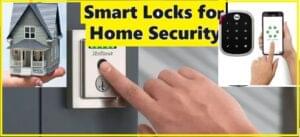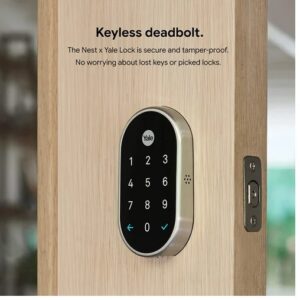Safety and Security of Home
Physical Security Measures:
- Install Security Systems:
- Consider installing a home security system that includes alarms, cameras, and motion sensors. Many modern systems offer smart features accessible via smartphones.
- Strong Locks: Use deadbolts, smart locks, or high-security locks on doors and windows to prevent unauthorized entry.
- Outdoor Lighting: Adequate lighting around the exterior of the house deters intruders. Motion sensor lights can be particularly effective.
- Secure Entry Points: Strengthen doors and windows with security bars, grilles, or films to prevent forced entry.
- Fencing: Secure the perimeter of your property with fences and gates, making it more challenging for unauthorized individuals to enter.

Safety Measures:
- Fire Safety: Install smoke detectors in various areas of your home. Also, have fire extinguishers readily available, and establish a fire escape plan for the family.
- Carbon Monoxide Detectors: Ensure you have carbon monoxide detectors installed, especially near sleeping areas. Carbon monoxide is an odorless, colorless gas that can be deadly.
- Child Safety: If you have children, childproof your home. Cover electrical outlets, secure cabinets, and keep potentially hazardous items out of reach.
- Prevent Falls: Use non-slip mats, secure rugs, and install handrails on staircases to prevent falls, especially for elderly family members.
General Home Safety:
- Regular Maintenance: Keep the home well-maintained. Fix any broken windows, doors, or other potential entry points.
- Secure Valuables: Use a safe to store important documents, jewelry, or valuable items.
- Smart Practices: Avoid sharing too much personal information online and be cautious about who you let into your home.
- Emergency Contacts: Keep emergency numbers and contact information for local services like police, fire department, and medical services easily accessible.
Community Measures:
- Neighborhood Watch: Consider forming or joining a neighborhood watch program to enhance community security.
- Good Relationships: Foster good relationships with your neighbors. They can provide an extra set of eyes when you’re away.
- Remember, maintaining safety and security is an ongoing process.
- Regularly reassess your home’s vulnerabilities and adapt security measures as needed. Customizing your security measures to suit your specific living situation is crucial in ensuring the safety of your home and loved ones.

Best smart lock for homes
- Selecting the best smart lock for your home depends on various factors such as compatibility with your existing setup, desired features, security levels, and personal preferences.
- some of the highly regarded smart locks were:
- August Wi-Fi Smart Lock:
- This lock is known for its easy installation and integration with various smart home systems.
- It offers remote access and monitoring through a mobile app.
- Yale Assure Lock SL:
- It’s a sleek, key-free smart lock that allows for code entry and integrates with many smart home platforms.
- The lock offers keypads for code entry, making it convenient for family members or visitors.
- Schlage Encode Smart Wi-Fi Deadbolt:
- This lock features built-in Wi-Fi and offers excellent security.
- It allows you to control the lock remotely, create access codes, and integrates with many smart home systems.
- Kwikset Halo Touch:
- Known for its fingerprint access, this smart lock allows you to unlock the door with a fingerprint and also offers traditional key access.
- Nest x Yale Lock: This lock is a collaboration between Nest and Yale. It integrates with the Nest ecosystem and provides keyless entry through passcodes and remote access via the Nest app.
Before purchasing a smart lock, consider these factors:
- Compatibility: Ensure the smart lock is compatible with your existing door and smart home system.
- Security: Look for a lock with strong encryption and built-in security features to prevent hacking.
- Convenience: Consider the ease of use, such as access methods (keypad, smartphone, key, or fingerprint), and remote control capabilities.
- Battery Life: Check the battery life and whether the lock has backup power options in case of battery failure.
- Installation: Some locks might require professional installation, while others are more DIY-friendly.

Research and Planning
- Assess Your Needs: Determine what features are essential for you in a smart lock. Do you need remote access, keyless entry, voice control, or integration with a smart home system?
- Compatibility: Check if the smart lock is compatible with your door. Some locks might require specific door types or modifications.
Considerations before Purchasing
- Type of Smart Locks:
- Deadbolt or Lever Locks: Choose the type suitable for your door.
- Connection Type: Wi-Fi, Bluetooth, or Z-Wave. Consider what works best for your setup.
- Features:
- Keyless Entry: Some locks offer keypads or smartphone apps for entry.
- Remote Access: Check if the lock allows you to control it remotely.
- Integration: Compatibility with smart home systems like Alexa, Google Assistant, or Apple HomeKit.
- Security and Encryption: Look for locks with robust security features and encryption to protect against hacking or unauthorized access.
- Battery Life: Check the lock’s battery life and how often it needs replacement.
Selection and Purchase
- Read Reviews and Compare Brands: Look at reviews, ratings, and comparisons between different smart locks to determine which one suits your needs and budget.
- Budget: Set a budget and find a smart lock that fits within your price range.
- Purchase: Once you’ve selected the right smart lock, make the purchase from reputable retailers, online stores, or directly from the manufacturer’s website.

Installation and Setup
- Installation: Some smart locks require professional installation, while others can be installed by following the manufacturer’s instructions. Ensure you’re comfortable with the installation process or hire a professional if needed.
- Setup and Configuration: Follow the manufacturer’s instructions to set up the lock. This might include connecting it to your smartphone, setting up access codes, or integrating it into your smart home ecosystem.
Additional Tips:
- Ensure the smart lock’s warranty and return policy.
- Double-check measurements and compatibility with your door before making the purchase.
- If you’re unsure, consult with a locksmith or someone familiar with smart lock installations for guidance.
- Always prioritize security and convenience when buying a smart lock for your doors.
- Make sure to do thorough research and consider your specific requirements before making a purchase.
